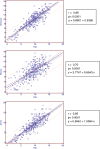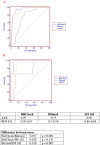Measuring transcutaneous bilirubin: a comparative analysis of three devices on a multiracial population
- PMID: 22697173
- PMCID: PMC3445817
- DOI: 10.1186/1471-2431-12-70
Measuring transcutaneous bilirubin: a comparative analysis of three devices on a multiracial population
Abstract
Background: Hyperbilirubinemia can lead to potentially irreversible bilirubin-induced neurotoxicity. Transcutaneous bilirubin (TcB) determination has become a valuable aid in non invasive screening of neonatal jaundice.The aim of this study is to compare the performance of three most widespread transcutaneous bilirubinometers on a multiracial population of term and late pre-term neonates.
Methods: Bilirubin concentration was determined using traditional photometric determination and transcutaneously with Bilicheck, BiliMed and JM-103, in random order.Total serum bilirubin (TSB) was determined over a wide concentration range (15,8-0,7 mg/dl) with a mean of 9,5 mg/dl. Related TcB values using Bilicheck (TcB-BC), BiliMed (TcB-BM), and JM-103 (TcB-JM) are reported in Table 1.
Results: A multiracial population of 289 neonates was enrolled with a gestational age ranging from 35 to 41 weeks; birth weight ranging from 1800 to 4350 grams; hours of life ranging from 4 to 424. In the total study population correlation analysis using Pearson coefficients showed good results for Bilicheck (r = 0.86) and JM-103 (r = 0.85) but poor for BiliMed (r = 0,70). Similar results were found for the non-Caucasian neonates subgroup. Bilicheck and JM-103 had a greater area under the curve than BiliMed when TSB =14 mg/dl was chosen as a threshold value both for the total study population and the non-Caucasian subgroup.
Conclusions: Bilicheck and JM-103, but not BiliMed, are equally reliable screening tools for hyperbilirubinemia in our multiracial neonatal population.
Figures



References
-
- Maisels MJ. Historical perspectives: transcutaneous bilirubinometry. NeoReviews. 2006;7:e217–e225. doi: 10.1542/neo.7-5-e217. - DOI
-
- Kazmierczak SC, Robertson AF, Catrou PG, Briley KP, Kreamer BL, Gourley GR. Direct spectrophotometry method for measurement of bilirubin in newborns: comparison with HPLC and an automated diazo method. Clin Chem. 2002;48:1096–1097. - PubMed
-
- De Luca D, Zecca E, Corsello M, Tiberi E, Semeraro C, Romagnoli C. Attempt to improve transcutaneous bilirubinometry: a double-blind study of Medick BiliMed versus Respironics BiliCheck. Arch Dis Child Fetal Neonatal Ed. 2008;93(2):F135–F139. - PubMed
Publication types
MeSH terms
Substances
LinkOut - more resources
Full Text Sources
Medical

